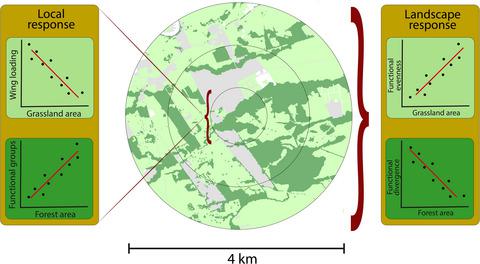当前位置:
X-MOL 学术
›
Biotropica
›
论文详情
Our official English website, www.x-mol.net, welcomes your
feedback! (Note: you will need to create a separate account there.)
Functional diversity of phyllostomid bats in an urban–rural landscape: A scale‐dependent analysis
Biotropica ( IF 1.8 ) Pub Date : 2020-07-30 , DOI: 10.1111/btp.12816 Andrés F. Ramírez‐Mejía 1, 2 , J. Nicolás Urbina‐Cardona 1 , Francisco Sánchez 2, 3
Biotropica ( IF 1.8 ) Pub Date : 2020-07-30 , DOI: 10.1111/btp.12816 Andrés F. Ramírez‐Mejía 1, 2 , J. Nicolás Urbina‐Cardona 1 , Francisco Sánchez 2, 3
Affiliation

|
Urbanization is one of the most pervasive processes of landscape transformation, responsible for novel selection agents promoting functional community homogenization. Bats may persist in those environments, but the mechanisms responsible for their adaptability and the spatial scales in which the landscape imposes environmental filtering remain poorly studied in the Neotropics. We tested the hypothesis that landscape composition interacts with the spatial scale to affect the functional diversity of phyllostomids in an urban–rural gradient. Based on functional traits, we calculated indices of functional richness, divergence, evenness, and community‐weighted means of morphological traits, and classified species into functional groups. We evaluated the changes in those variables in response to forest, grassland, and urbanized areas at 0.5, 1.25, and 2km scales. The number of functional groups, functional richness, and functional evenness tended to be higher in areas far from cities and with higher forest cover, whereas functional divergence increased in more urbanized areas. Our results show that the mean value of wing loading in the assemblage was negatively associated with landscape transformation at several spatial scales. However, environmental filtering driven by grass cover was particularly robust at the 0.5km scale, affecting big‐sized species with long‐pointed wings. Retaining natural forest in cattle ranging systems at ~12 km2 appears to favor the functional evenness and number of functional groups of phyllostomids. Recognizing the scale of the effect on phyllostomid functional responses appears to be a fundamental issue for elucidating the spatial extent to which phyllostomid conservation planning in urban–rural landscapes should be addressed.
中文翻译:

城乡景观中叶甲类蝙蝠的功能多样性:尺度依赖分析
城市化是最普遍的景观改造过程之一,负责促进功能性社区同质化的新型选择剂。蝙蝠在这些环境中可能会持续存在,但是在新热带地区,对蝙蝠适应性和景观施加环境过滤的空间尺度的机理仍然研究不足。我们检验了景观组成与空间尺度相互作用以影响城乡梯度中叶绿体功能多样性的假说。基于功能性状,我们计算了功能性丰富度,差异性,均匀性和形态特征的社区加权平均值的指数,并将物种分类为功能性组。我们评估了这些变量对森林,草地和城市化地区的响应变化,分别为0.5、1.25,和2公里的规模。在远离城市和森林覆盖率较高的地区,功能群的数量,功能丰富度和功能均匀性趋于更高,而在城市化程度更高的地区,功能差异则增加。我们的结果表明,在几个空间尺度上,机翼组合中机翼载荷的平均值与景观转换成负相关。但是,由草皮驱动的环境过滤在0.5 km的范围内尤其强大,影响了带有长翅膀的大型物种。在约12公里处的牲畜测距系统中保留天然林 我们的结果表明,在几个空间尺度上,机翼组合中机翼载荷的平均值与景观转换成负相关。但是,由草皮驱动的环境过滤在0.5 km的范围内尤其强大,影响了带有长翅膀的大型物种。在约12公里处的牲畜测距系统中保留天然林 我们的结果表明,在几个空间尺度上,机翼组合中机翼载荷的平均值与景观转换成负相关。但是,由草皮驱动的环境过滤在0.5 km的范围内尤其强大,影响了带有长翅膀的大型物种。在约12公里处的牲畜测距系统中保留天然林2似乎有利于叶甾醇类的功能均匀性和官能团数。认识到对叶绿体功能响应的影响程度似乎是阐明应解决城乡景观中的叶绿体保护规划的空间范围的基本问题。
更新日期:2020-07-30
中文翻译:

城乡景观中叶甲类蝙蝠的功能多样性:尺度依赖分析
城市化是最普遍的景观改造过程之一,负责促进功能性社区同质化的新型选择剂。蝙蝠在这些环境中可能会持续存在,但是在新热带地区,对蝙蝠适应性和景观施加环境过滤的空间尺度的机理仍然研究不足。我们检验了景观组成与空间尺度相互作用以影响城乡梯度中叶绿体功能多样性的假说。基于功能性状,我们计算了功能性丰富度,差异性,均匀性和形态特征的社区加权平均值的指数,并将物种分类为功能性组。我们评估了这些变量对森林,草地和城市化地区的响应变化,分别为0.5、1.25,和2公里的规模。在远离城市和森林覆盖率较高的地区,功能群的数量,功能丰富度和功能均匀性趋于更高,而在城市化程度更高的地区,功能差异则增加。我们的结果表明,在几个空间尺度上,机翼组合中机翼载荷的平均值与景观转换成负相关。但是,由草皮驱动的环境过滤在0.5 km的范围内尤其强大,影响了带有长翅膀的大型物种。在约12公里处的牲畜测距系统中保留天然林 我们的结果表明,在几个空间尺度上,机翼组合中机翼载荷的平均值与景观转换成负相关。但是,由草皮驱动的环境过滤在0.5 km的范围内尤其强大,影响了带有长翅膀的大型物种。在约12公里处的牲畜测距系统中保留天然林 我们的结果表明,在几个空间尺度上,机翼组合中机翼载荷的平均值与景观转换成负相关。但是,由草皮驱动的环境过滤在0.5 km的范围内尤其强大,影响了带有长翅膀的大型物种。在约12公里处的牲畜测距系统中保留天然林2似乎有利于叶甾醇类的功能均匀性和官能团数。认识到对叶绿体功能响应的影响程度似乎是阐明应解决城乡景观中的叶绿体保护规划的空间范围的基本问题。











































 京公网安备 11010802027423号
京公网安备 11010802027423号